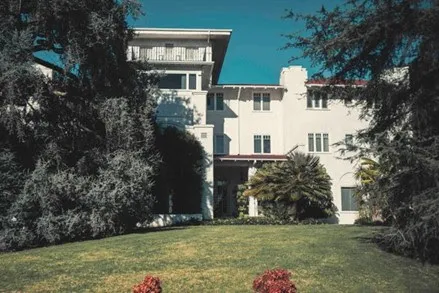During the week of October 7-11, twenty-six Ananda members
from the Pacific Northwest visited the places in southern California where
Paramhansa (Paramahansa) Yogananda lived and taught. Prior to the years of the pandemic,
such pilgrimages were common every few years. In fact, the week before our
group traveled, another such group from Ananda in the San Francisco Bay Area
visited as well. |
| Mt Washington |
Our stops were as follows: Self-Realization
Meditation Gardens in Encinitas; SRF International Headquarters on Mt.
Washington in Los Angeles; Forest Lawn Cemetery in Glendale; SRF Hollywood Temple;
and SRF Lake Shrine in Pacific Palisades. We stayed two nights at the Biltmore
Hotel in downtown Los Angeles. This is the sight where Paramhansa Yogananda
left his body on March 7, 1952, in a crowded banquet hall in honor of the newly appointed ambassador from India to the United States.In addition, we had meditations in Encinitas at the
Temple of Joy owned by Casey Hughes. The SRF shrines are beautifully maintained
and enveloped in meditative silence and peace. The outdoor
gardens that surround these locations are exquisitely beautiful. The monastics
(monks and nuns plus volunteers) who curate these shrines are generally very
calm, kind, and inward. The buildings, though aging, appear to be immaculately
maintained. In short, these shrines are a Disneyland of divine consciousness for a meditator and follower (disciple) of Yogananda. |
| Encinitas bluff |
We were privileged to take turns in small groups going
upstairs to the third-floor rooms where Yogananda lived at Mt. Washington,
overlooking downtown Los Angeles. The atmosphere is deeply hushed, and the
sense of timelessness and transcendence is as tangible as Yogananda’s overstuffed
chair draped with his ochre-colored shawl. His adjacent bedroom also vibrates
with his presence and emits an aura of simplicity and peace. The downstairs
chapel—site of kriya initiations, meditations, and ceremonies where Yogananda
experienced God and various saints—drew us like a giant magnet to sit and
meditate. |
| SRF Hollywood Church |
When so deeply committed to maintaining these shrines, the task is not unlike operating a museum. The atmosphere is hushed. Indeed, any loud talking or group activity is generally nipped in the bud by the nearest docent or monastic. Even sitting on the floor in one of the chapels (as is common with meditators) is not allowed. This is not surprising since thousands visit these places every year and without clear oversight (aka rules) visitors would likely create disruptions and attract attention to themselves by practicing yoga exercises out on the lawns, expressing excessive devotional postures, chanting aloud and so on in time, if not monitored and even suppressed, create a very un-museum like atmosphere.
 |
| Lake Shrine |
This kind of strict control blends harmoniously with
traditional monastic attitudes such as obedience, silence, and humility. The
monastics are all neatly attired: monks in simple high-collar short-sleeved
shirts; and nuns in yellow saris. We were privileged to watch a silent video of Yogananda
conducting the dedication ceremonies at the Hollywood Temple (August 30, 1942).
In that video, one could see the energetic, creative, and dynamic way Yogananda
related to the public at large. At that location, he started a Mushroom Burger
stand and held Indian cultural events, and in Encinitas, he experimented with what
he called a “world brotherhood colony” as a pilot program for future
intentional communities, he had a carrot juice processing plant, and a small
farm, among other how-to enterprises to provide support for the work and for
the residents. He created many vegetarian recipes, shared healing
techniques, and spoke on topics such as material success, leadership, social
justice, politics, marriage, and child-raising to mention just a few. The
mission of preservation began some years after Yogananda’s passing in 1952 and
after the passing of his non-monastic male successors. While SRF also conducts
public teaching, retreats, and outreach, none of that comes even close to
matching Yogananda’s expansive energy and consciousness. Most notably, then,
SRF has embraced the Vishnu or preserving aspect of creativity and has done a
wonderful job of that. We visited Forest Lawn Cemetary in nearby Glendale and chanted and meditated in front of where Yogananda's body is interred. We also stayed two nights at the grand hotel the Biltmore where Yogananda left his body on March 7, 1952 at a banquet he held in honor of the newly appointed ambassador from India to America. |
Biltmore Hotel
Where Yogananda
left his body |
 |
Yogananda's crypt
|
Ananda, by contrast, is more akin to the
spirit of Yogananda during those dynamic years of his life of constant travel,
creativity, and outreach. Ananda was founded by Swami Kriyananda who came to
Yogananda in 1948 and was accepted by Yogananda into the ashram as a monk in
their very first meeting at the Hollywood Church. Within a year the young “Rev.
Walter” (as Yogananda addressed Swami Kriyananda) was giving kriya initiation and was given the position of head monk (even though many of the monks were twice as
old as Kriyananda (22 years old in 1948), and was giving classes and Sunday
Services at both Hollywood Church and the San Diego SRF Church. By the late
1950s, Kriyananda was on the SRF board of directors.Swami Kriyananda took seriously the thundering call to action
by Yogananda on that day in July 1949 at a Beverly Hills garden party for the
establishment of world brotherhood colonies which he predicted would someday
spread like wildfire. Swami Kriyananda was the only one out of nearly 800
people in attendance that day who later established such a community. So, in contrast to the SRF mission of preservation (Vishnu-like),
Ananda’s mission is the “Brahma-like” aspect of the outflowing creative force
(Holy Spirit or Aum vibration).The group’s visit to Casey Hughes’ “Temple of Joy” in
Encinitas was primarily for the purpose of finding a place for group meditation
and chanting. Casey’s is the “Shiva-like” energy of dissolving outward forms of
organization to affirm the universal aspects of Yogananda’s mission in seeing
in all faith-forms the central and sole reality of God. Casey’s Temple of Light
seeks to honor all forms of worship and practice. These three represent what is taught in India and by
Yogananda as the three faces of the Holy Spirit, or Divine Mother as the creative
vibration that makes possible and visible all creation and consciousness. One
aspect brings into manifestation the forms of creation; another, preserves
those forms; yet another dissolves them. None can exist without the other. Yogananda called his temples “churches of all religions” but
unsurprisingly few people understood his intention in using that phrase. He
didn’t mean that each faith tradition would be practiced there; nor yet that
his was a syncretization of all faith traditions. Rather, the practice of
meditation, and especially advanced forms of meditation such as the Kriya Yoga
he brought to the public, works directly on our consciousness through the
vehicle of breath and life force to reunite with soul force with the goal to
achieve God-realization: the very purpose of our creation. Such upliftment and
the goal of Self-realization is the “religion” underlying all faith traditions.Each of these three expressions were beautifully expressed
by Yogananda during his life. His years of “barnstorming” around the country,
his printed lessons in meditation and yoga philosophy, and his writings
represent his Brahma aspect. His cultivation of celebrities and “influencers” and
his promotion of cross-cultural appreciation and racial integration were part
of his socio-political activism. At the same time, he established in southern California his
headquarters and later branch churches and a monastic order of monks and nuns
to be the nucleus of his organization in his Vishna-aspect.His Shiva-aspect was his insistence on
the universality of the teachings of Sanaatan Dharma and the practice of Kriya
Yoga for all sincere people and as the “religion” of the dawning new age (of
“Dwapara Yuga”).  |
| Casey's Temple of Joy |
There has been and perhaps always will be some tension
between these three aspects. However, even when one aspect appears more
dominant than another, all three aspects must be nurtured at least to some
degree for the specific expression to maintain its integrity and attunement to
Yogananda’s vibration and mission. Too much Brahma becomes restless and
scattered. Too much Vishnu becomes rigid. Too much Shiva loses vitality and identity.
Thus, SRF has tried to energize a lay order emphasizing community. Ananda has
established a religious order, and Casey’s Temple of Light strives to maintain
harmonious relations with the other two and with many other spiritual paths!In our group’s pilgrimage I could see that some members of
the group resonated more with one or the other aspect. SRF’s expression is so
neat and beautifully maintained as to seem perfect, even if, people being
people, one imagines that behind closed doors are the usual challenges inherent
in a rigidly controlled way of life. Ananda is fun-loving, inclusive, and
creative but the individual discipline, inwardness, and dignity needed for
attunement and the practice of meditation might seem lacking to some people.
Casey’s Temple of Light mission seems free from all limitations imposed by
self-definition but compared to SRF or Ananda is limited to few people. It is
free and open to all (wonderful) but carried (mostly I assume) by Casey and his
partner alone.All in all, our group had a deeply blessed experience and all
are grateful for those devotees who greeted and hosted us at each location as
representatives of our guru, Paramhansa Yogananda. May we each keep marching on
the “only path there is” (inward and upward) in our own unique way.










